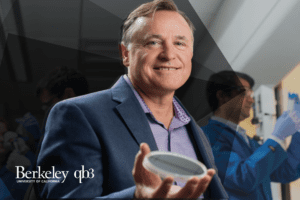Kevin E. Healy is the Jan Fandrianto and Selfia Halim Distinguished Professor in Engineering at the University of California at Berkeley in the Departments of Bioengineering, and Materials Science and Engineering. His group currently conducts research in the areas of: bioinspired stem cell microenvironments to control stem cell lineage specification and self-organization into microtissues or organoids; bioinspired systems for regenerative medicine; biological interfaces; and, microphysiological systems for drug development and gene editing.
QB3-Berkeley: What’s an exciting question or challenge that your field and or your lab is trying to answer right now?
Kevin Healy: There are many to choose from! The most pressing question may be in the area of regenerative medicine, where we’re making different types of hydrogels based on natural biopolymers that assist in tissue regeneration after injury. These hydrogels have tunable features that we can design for specific organs and tissues. Furthermore, they are designed to interact directly with a patient’s cells, and then the cells remodel the biomaterial; it’s a dynamic relationship that results in vascularized regenerated tissue.
QB3: Could you tell us about your path to becoming a scientist?
KH: My interest in medicine started when I was about 10. Later, as a student, I got really interested in cardiovascular health, and I was accomplished enough at math, chemistry, and physics in high school to be asked to enter a chemical engineering program as an undergraduate. In that program, I wasn’t really interested in the petrochemical industry, but I was fascinated by the idea that scientists could help shape human health outcomes by making devices and therapies from materials, which is what led me to where I am today.

QB3: What brought you to UC Berkeley?
KH: I was a professor at Northwestern University for 10 years before I came to Berkeley. When I finished my PhD, I was fortunate to be in a position where I didn’t need to do a postdoc; I was able to enter straight into the path of an academic career and went through the tenure track process. Then it was clear that our kids were getting old enough and my family was in the San Francisco Bay Area. My wife’s family was still in New York City, which is where we’re both from. The decision to move was for family unification; we were either going to go back to the East Coast or to try to get out to California. Berkeley is a wonderful place and I’ve been so fortunate to have my lab here and be part of the community.
QB3: What do you like best about working with students in your lab?
KH: As a mentor, what’s most exciting for me is working with trainees that are highly motivated and imaginative. From the unbridled enthusiasm of undergraduates just entering the lab to postdocs with years of lab training, I draw energy from them as they continue to mature and learn. I value the opportunity to provide the mentorship for the students for any career path, whether it’s in academia, government, or working in the private sector.
QB3: What does being part of QB3-Berkeley mean to you?
KH: QB3 is an exciting collection of scientists, and the beauty of Berkeley is that there’s talent across the entire campus. Being part of QB3-Berkeley, it’s easy to think of an idea where you might need collaborators to support new research endeavors since, to launch these kinds of ideas, collaboration is essential. Establishing collaborations is an instrumental part of what being part of QB3-Berkeley means to me. Additionally, QB3-Berkeley’s ecosystem is great for students since it gives them an opportunity to interact with one another and experience cross fertilization across labs and scientific disciplines.